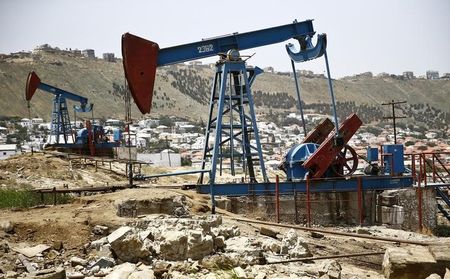Commodities
Oil prices drift lower, but set for weekly gains after hefty Fed cut

Investing.com– Oil prices retreated Friday, but were still headed for a weekly gain as a bumper U.S. interest rate cut helped quell some fears of slowing demand.
At 08:20 ET (12:20 GMT), fell 0.6% to $74.47 a barrel, while dropped 0.5% to $70.79 a barrel.
Oil heads for weekly gains on rate cut cheer
Crude prices have staged a strong recovery from near three-year lows hit earlier in September, with a bulk of their rebound coming this week as the dollar retreated on a by the Federal Reserve.
was trading up about 3.95% this week, while WTI futures were up 4.4%.
Increased tensions in the Middle East also aided crude, after Israel allegedly exploded pagers and walkie talkies belonging to Hezbollah members, sparking vows of retaliation. Fighting in and around Gaza also continued.
A softer aided crude prices after the Fed cut interest rates by the top end of market expectations and announced an easing cycle, which traders bet will help spur economic growth in the coming quarters.
Lower rates usually bode well for economic activity, which in turn is expected to buoy crude demand.
China demand concerns persist
But China remained a key point of contention for crude markets, as economic readings from the world’s biggest oil importer showed little signs of improvement.
The People’s Bank of China kept unchanged on Friday, despite mounting calls on Beijing to unlock more stimulus for the economy.
Data released earlier in September showed Chinese refinery output slowed for a fifth straight month in August, while the country’s oil imports also remained mostly weak.
Concerns over China dragged oil prices to a near three-year low earlier this month, and have limited any major recovery in crude.
“China has obviously been the key concern when it comes to demand, but there have also been reports of refiners in Europe cutting run rates due to poor margins,” said analysts at ING, in a note.
(Ambar Warrick contributed to this article.)
Commodities
Oil prices rise; U.S. crude inventories plunge, Russia-Ukraine truce eyed
Commodities
India’s Reliance to stop buying Venezuelan oil over US tariffs, sources say
Commodities
Oil prices climb on Venezuela supply worries

 Forex3 years ago
Forex3 years agoForex Today: the dollar is gaining strength amid gloomy sentiment at the start of the Fed’s week

 Forex3 years ago
Forex3 years agoUnbiased review of Pocket Option broker

 Forex3 years ago
Forex3 years agoDollar to pound sterling exchange rate today: Pound plummeted to its lowest since 1985

 Forex3 years ago
Forex3 years agoHow is the Australian dollar doing today?

 Cryptocurrency3 years ago
Cryptocurrency3 years agoWhat happened in the crypto market – current events today

 World3 years ago
World3 years agoWhy are modern video games an art form?

 Commodities3 years ago
Commodities3 years agoCopper continues to fall in price on expectations of lower demand in China

 Economy3 years ago
Economy3 years agoCrude oil tankers double in price due to EU anti-Russian sanctions

























